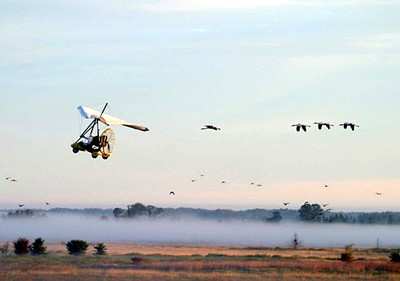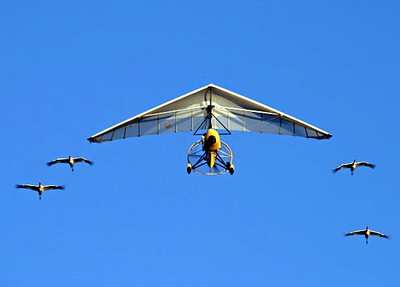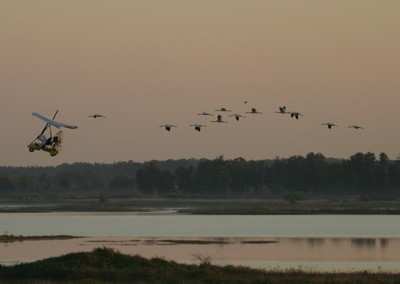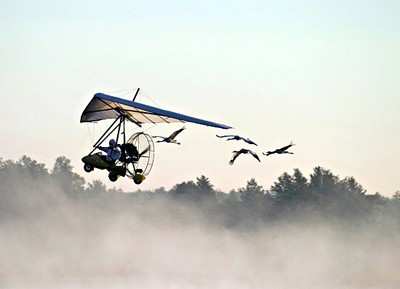They Did It Again!
Thirteen endangered whooping cranes and their surrogate
parents—three ultralight aircraft—reached
Chassahowitzka National Wildlife Refuge shortly after 9 a.m.
Eastern today after a 64-day, 1,200-mile trek over seven
states.

The young cranes made a rare public appearance, flying over a
welcoming crowd of supporters at the Crystal River Mall in Crystal
River, just prior to landing at a special four-acre site at
Chassahowitzka. Despite suffering damage from some of the four
hurricanes that hit Florida this year, the site was ready for the
birds' arrival.
"Though hurricanes damaged more than 90 percent of the fencing
around the pen, staff, refuge volunteers and volunteers from other
agencies and refuges all came together to repair the damage,”
said Chassahowitzka NWR Manager Jim Kraus. "Everyone did a stellar
job and we thank them for their contribution to this reintroduction
effort."

The Whooping Crane Eastern Partnership (WCEP), an international
coalition of public and private organizations, is conducting this
ultralight-led reintroduction project in an effort to return this
highly imperiled species to its historic range in eastern North
America.
The cranes left Necedah, WI, on Oct. 10, following ultralight
aircraft flown by Operation Migration, Inc., pilots. International
Crane Foundation, US Fish and Wildlife Service and Wisconsin
Department of Natural Resources biologists will monitor their
winter behavior and track them on their anticipated spring
migration north in 2005.

A day before reaching Chassahowitzka NWR, one of the young birds
of the Class of 2004, Number 6, died. On Dec. 10, migration team
members discovered her lethargic in her traveling pen and attempted
to give her fluids at the recommendation of veterinarians.
Though she seemed to respond to the fluids, 6-04 appeared in
need of medical attention, and crewmembers carefully hooded her and
drove her to the University of Florida College of Veterinary
Medicine, where doctors examined her. The bird's white blood cell
count extremely high and she showed evidence of parasitic and
bacterial infections. To prevent any further stress, veterinarians
euthanized number 6-04 on Dec. 11.
These birds are the fourth generation of whooping cranes to make
this unique assisted migration from Wisconsin to Florida. Cranes
from the ultralight-led migration classes of 2001, 2002 and 2003
are making or have completed their own unassisted southward
migrations, representing another milestone in this historic
reintroduction effort.

In 2001, project partner Operation Migration’s pilots led
the first whooping crane chicks, conditioned to follow their
ultralight surrogates south from Necedah NWR to Chassahowitzka NWR
on Florida’s Gulf Coast. In 2002, WCEP biologists and pilots
conditioned and guided a second group of juvenile cranes to
Chassahowitzka NWR. In the fall of 2003, WCEP conducted its third
ultralight-led migration. With the success of this fall’s
migration, there are now 48 whooping cranes in the wild in eastern
North America.
WCEP asks anyone who encounters a whooping crane in the wild to
please give them the respect and distance they need. Do not
approach birds on foot within 600 feet; try to remain in your
vehicle; do not approach in a vehicle within 600 feet or, if on a
public road, within 300 feet. Also, please remain concealed and do
not speak loudly enough that the birds can hear you. Finally, do
not trespass on private property in an attempt to view whooping
cranes.

The whooping crane chicks that take part in the reintroduction
project are hatched at the US Geological Survey’s Patuxent
Wildlife Research Center in Laurel, MD. There, the young cranes are
introduced to ultralight aircraft and raised in isolation from
humans. To ensure the impressionable cranes remain wild, project
biologists and pilots adhere to a strict no-talking rule, broadcast
recorded crane calls and wear costumes designed to mask the human
form whenever they are around the cranes.
New classes of cranes are transported to Necedah NWR each June
to begin a summer of conditioning behind the ultralights to prepare
them for their fall migration. Pilots lead the birds on gradually
longer training flights at the refuge throughout the summer until
the young cranes are deemed ready to follow the aircraft along the
migration route.
Graduated classes of whoopers spend much of their time during
the summer on or near the Necedah and Horicon national wildlife
refuges, both of which are in central Wisconsin. They also use
state and private lands. It is not unusual for yearling female
cranes to wander, especially if they are not associating with any
male flockmates, which typically select the future breeding
territory.

Project staff from the International Crane Foundation and the US
Fish and Wildlife Service track and monitor southbound cranes in an
effort to learn as much as possible about their unassisted journeys
and the habitat choices they make along the way. ICF and FWS
biologists actively track the cranes as they make their way north,
and continue to monitor the birds, along with Wisconsin DNR
biologists, while the whooping cranes are in their summer
locations.
Whooping cranes were on the verge of extinction in the 1940s.
Today, there are only about 275 birds in the wild. Aside from the
35 Wisconsin-Florida birds, the only other migrating population of
whooping cranes nests at the Wood Buffalo National Park in the
Northwest Territories of Canada and winters at the Aransas National
Wildlife Refuge on the Texas Gulf Coast. A non-migrating flock of
approximately 100 birds lives year-round in the central Florida
Kissimmee region.
Whooping cranes, named for their loud and penetrating unison
calls, live and breed in wetland areas, where they feed on crabs,
clams, frogs and aquatic plants. They are distinctive animals,
standing five feet tall, with white bodies, black wing tips and red
crowns on their heads.

Whooping Crane Eastern Partnership founding members include the
International Crane Foundation, Operation Migration Inc., Wisconsin
Department of Natural Resources, US Fish and Wildlife Service, the
US Geological Survey’s Patuxent Wildlife Research Center and
National Wildlife Health Center, the National Fish and Wildlife
Foundation, the Natural Resources Foundation of Wisconsin, and the
International Whooping Crane Recovery Team.
Many other flyway states, provinces, private individuals and
conservation groups have joined forces with and support WCEP by
donating resources, funding and personnel. More than 60 percent of
the project’s estimated $1.8 million budget comes from
private sources in the form of grants, public donations and
corporate sponsors.
 ANN's Daily Aero-Linx (04.16.24)
ANN's Daily Aero-Linx (04.16.24) Aero-News: Quote of the Day (04.16.24)
Aero-News: Quote of the Day (04.16.24) Airborne 04.10.24: SnF24!, A50 Heritage Reveal, HeliCycle!, Montaer MC-01
Airborne 04.10.24: SnF24!, A50 Heritage Reveal, HeliCycle!, Montaer MC-01 Airborne 04.12.24: SnF24!, G100UL Is Here, Holy Micro, Plane Tags
Airborne 04.12.24: SnF24!, G100UL Is Here, Holy Micro, Plane Tags Airborne-Flight Training 04.17.24: Feds Need Controllers, Spirit Delay, Redbird
Airborne-Flight Training 04.17.24: Feds Need Controllers, Spirit Delay, Redbird









